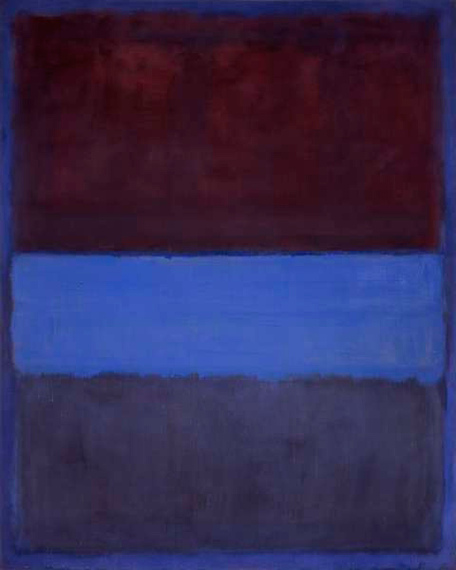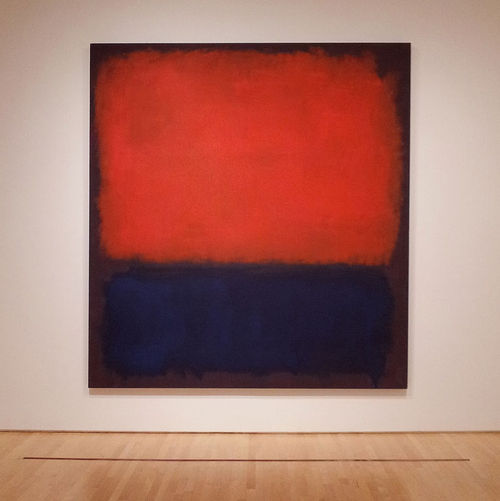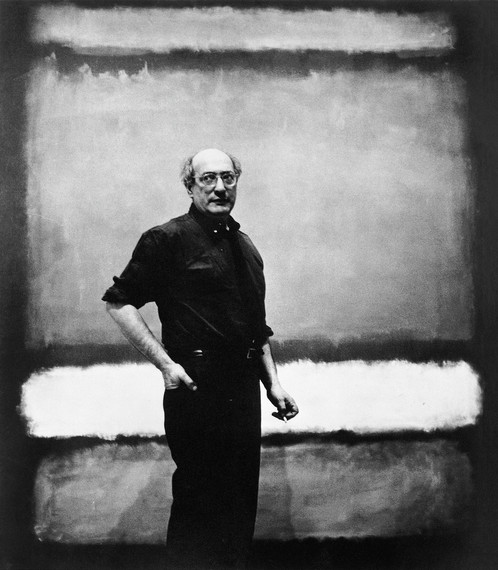Holland might seem an unlikely place to go to see the art of a great American artist, but I am here to tell you it is worth the trip. A retrospective exhibition of the art of Mark Rothko will be on display all fall at The Hague's Gemeentemuseum. The careful selection of the paintings and the elegant setting - the last building designed by the Dutch architect Hendrik Berlage -- make this a memorable exhibition.
 |
The exhibition presents a concise visual narrative of the late and gradual development and magnificent late maturation of a great artistic seeker -- an experimental painter who began with enormous ambitions, to produce an art that would serve the modern world as the art of Aeschylus served ancient Greece, and that of Fra Angelico served Renaissance Italy, but with little or no idea of how to achieve this imposing goal. In a 1943 letter to the New York Times signed by the 40-year old Rothko and his friend Adolph Gottlieb, the artists declared that "To us art is an adventure into an unknown world, which can be explored only by those willing to take the risks." This exhibition makes it clear that the declaration was sincere.
The first room of the exhibition presents the surprising spectacle of a preparatory drawing for a figure composition, with a superimposed grid that would allow the drawing to be transferred to a larger support. This attests eloquently to Rothko's late development, for the drawing is dated 1941/2, when Rothko was just shy of 40 years old. Abstract Expressionism would have no common style: it would span individual gestures as diverse as those of Jackson Pollock, Willem de Kooning, and Rothko. One of the few beliefs, and practices, that united its dozens of practitioners was the absence of preconception, and the complete rejection of preparatory drawings as an outdated practice. The tell-tale drawing demonstrates that Rothko had not yet arrived at this understanding by the end of his fourth decade. A bizarre canvas in the same room, Underground Fantasy of 1940, shows Rothko translating Surrealism to the unlikely setting of the New York subway, with thin, elongated figures waiting for a train in a dream sequence. Rothko was neither gifted nor precocious as a young artist. The first room of this show witnesses his struggles with both subject matter and technique -- drab colors create unconvincing figures that relate vaguely to Surrealism and Greek mythology.
The mature Rothko begins to emerge in the late 1940s. His early, vertical Surrealist forms give way to increasingly horizontal rectangles, with stronger, more vibrant colors. A beautiful, tall, untitled canvas of 1949 contains bright reds, greens, and browns, done with vigorous brushstrokes. By the early 1950s, around the age of 50, Rothko finally settles into his trademark stacked rectangles. These paintings are much more beautiful in person than in reproduction, because of the movement created by the visible brushstrokes: the forms of these paintings shimmer.
 |
The glory of the show, and of Rothko's career, is in the final rooms. Rothko reached his full maturity as an artist in the late 1950s and the '60s; he produced masterpieces, by layering strong and assertive colors patiently onto large canvases. These paintings are inspiring and powerful, beautiful and deep, both visually and psychologically, like the great stained glass of French cathedrals. The best of these paintings draw the viewer into them. Rothko wanted his paintings to envelop viewers, and these often succeed in doing that.
The Abstract Expressionists knew they had created a genuinely innovative art, and they believed it would become firmly rooted in western society: in the early 1950s, Rothko told a friend that he and his friends were producing an art that would last for a thousand years. In the event, the revolution lasted barely another decade, before it collapsed under the attack of Rauschenberg, Johns, Warhol, and the legions of young conceptual artists they inspired. It was Rothko's misfortune to witness the triumph of Pop and Minimalism, and to see the idealism of his cohort replaced by the cynicism and irreverence of the next. It is difficult not to see Rothko's late depression, and the all black canvases of the '60s, as a product, at least in part, of this experience: as the painter Karl Schrag observed, "the problem was not just being replaced, but what was replacing him." But for anyone who loves the beauty of great Abstract Expressionist art, the rooms of the Gemeentemuseum allow visitors to follow the gradual process by which one great artist proceeded from inexperience and ineptitude to maturity and glorious achievement.
 |
Rothko's late works are a vivid reminder of an era not terribly distant from ours in time, but radically different in attitudes both social and artistic. Late in his life, Rothko had the satisfaction of being awarded an honorary doctorate by Yale University, which he had quit decades earlier in disgust at its bigotry and lack of real commitment to learning. In accepting the degree, he recalled that when he was young,
Today, the magnificent paintings that he produced in that era can serve to remind us of the shame of anti-Semitism and the neglect of a generation of great artists even as we regret the disappearance of an intellectual climate in which artists could speak of heroism and beauty without irony or fear of being mocked by their peers.
Art was a lonely thing: no galleries, no collectors, no critics, no money. Yet it was a golden time, for then we had nothing to lose and a vision to gain.
The Gemeentemuseum is unfortunately off the beaten path for tourists to Holland. Yet it is just a ten-minute taxi ride from the Mauritshuis, which is a familiar destination for tourists in search of Vermeer, Hals, and Rembrandt. If you do visit the Gemeentemuseum, you can also see two other excellent exhibitions: a major show devoted to Mondrian and de Stijl, and a wide-ranging survey, titled Discover the Modern, that features the strengths of the museum's superb permanent collection, from Monet and Maris through van Gogh and Mondrian to Morandi and Judd. I have been a regular visitor to the Gemeentemuseum for several decades, and I have never seen as much great art there as is currently on display.